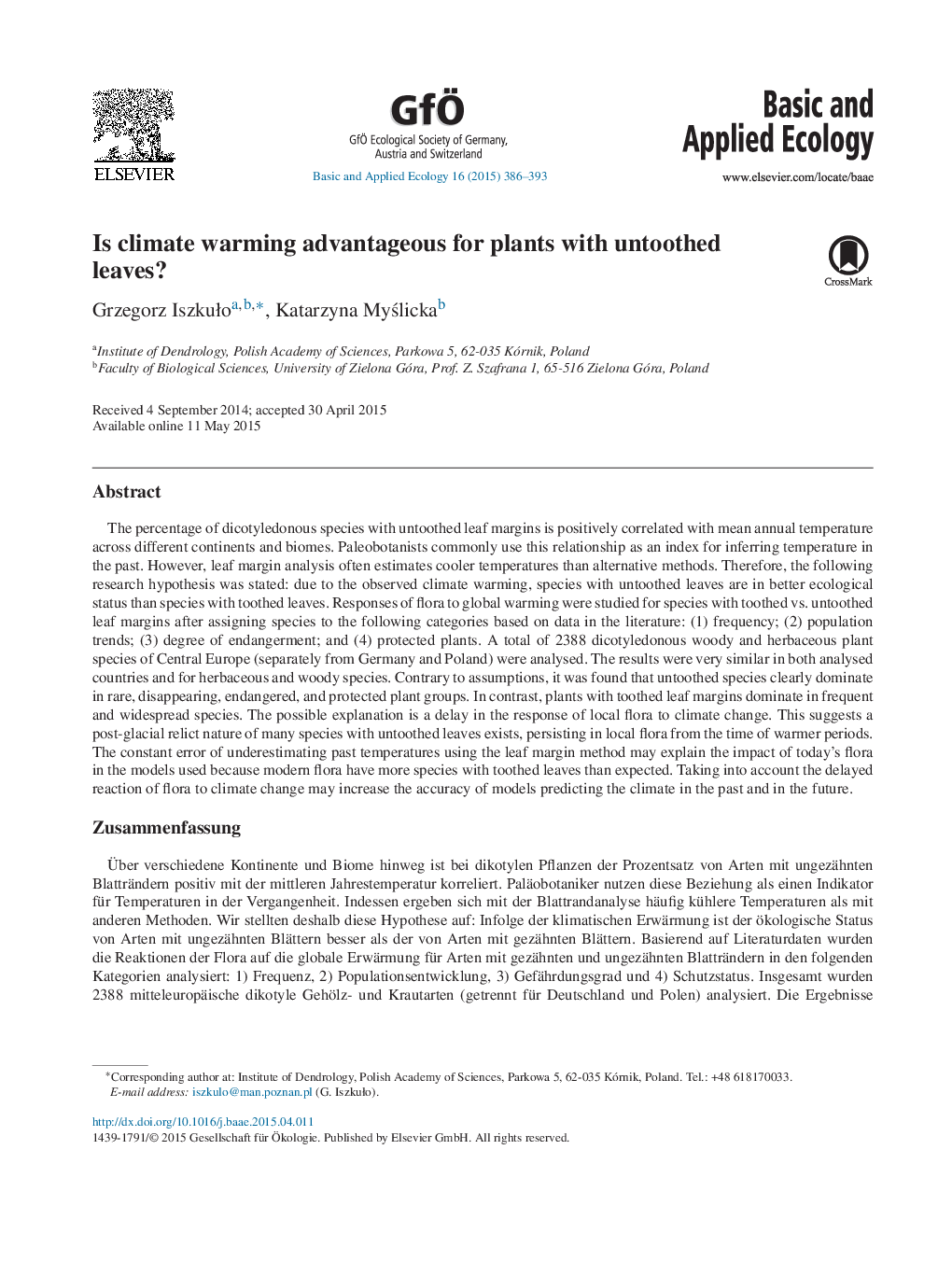| کد مقاله | کد نشریه | سال انتشار | مقاله انگلیسی | نسخه تمام متن |
|---|---|---|---|---|
| 4384070 | 1304387 | 2015 | 8 صفحه PDF | دانلود رایگان |
The percentage of dicotyledonous species with untoothed leaf margins is positively correlated with mean annual temperature across different continents and biomes. Paleobotanists commonly use this relationship as an index for inferring temperature in the past. However, leaf margin analysis often estimates cooler temperatures than alternative methods. Therefore, the following research hypothesis was stated: due to the observed climate warming, species with untoothed leaves are in better ecological status than species with toothed leaves. Responses of flora to global warming were studied for species with toothed vs. untoothed leaf margins after assigning species to the following categories based on data in the literature: (1) frequency; (2) population trends; (3) degree of endangerment; and (4) protected plants. A total of 2388 dicotyledonous woody and herbaceous plant species of Central Europe (separately from Germany and Poland) were analysed. The results were very similar in both analysed countries and for herbaceous and woody species. Contrary to assumptions, it was found that untoothed species clearly dominate in rare, disappearing, endangered, and protected plant groups. In contrast, plants with toothed leaf margins dominate in frequent and widespread species. The possible explanation is a delay in the response of local flora to climate change. This suggests a post-glacial relict nature of many species with untoothed leaves exists, persisting in local flora from the time of warmer periods. The constant error of underestimating past temperatures using the leaf margin method may explain the impact of today's flora in the models used because modern flora have more species with toothed leaves than expected. Taking into account the delayed reaction of flora to climate change may increase the accuracy of models predicting the climate in the past and in the future.
ZusammenfassungÜber verschiedene Kontinente und Biome hinweg ist bei dikotylen Pflanzen der Prozentsatz von Arten mit ungezähnten Blatträndern positiv mit der mittleren Jahrestemperatur korreliert. Paläobotaniker nutzen diese Beziehung als einen Indikator für Temperaturen in der Vergangenheit. Indessen ergeben sich mit der Blattrandanalyse häufig kühlere Temperaturen als mit anderen Methoden. Wir stellten deshalb diese Hypothese auf: Infolge der klimatischen Erwärmung ist der ökologische Status von Arten mit ungezähnten Blättern besser als der von Arten mit gezähnten Blättern. Basierend auf Literaturdaten wurden die Reaktionen der Flora auf die globale Erwärmung für Arten mit gezähnten und ungezähnten Blatträndern in den folgenden Kategorien analysiert: 1) Frequenz, 2) Populationsentwicklung, 3) Gefährdungsgrad und 4) Schutzstatus. Insgesamt wurden 2388 mitteleuropäische dikotyle Gehölz- und Krautarten (getrennt für Deutschland und Polen) analysiert. Die Ergebnisse waren sowohl für die beiden untersuchten Länder als auch für die Gehölz- und Krautarten sehr ähnlich. Im Gegensatz zu den Annahmen dominierten ungezähnte Arten eindeutig bei den seltenen, verschwindenden, gefährdeten und geschützten Pflanzen. Dagegen dominieren Pflanzen mit gezähnten Blatträndern bei den häufigen und weit verbreiteten Arten. Dies legt nahe, dass viele Arten mit ungezähnten Blättern eine postglaziale Relikteigenschaft aufweisen, die in der lokalen Flora aus Zeiten wärmerer Perioden überdauert. Der beständige Fehler, Temperaturen in der Vergangenheit nach der Blattrand-Methode zu unterschätzen, könnte mit dem Einfluss der heutigen Flora bei der Modellbildung erklärt werden, weil moderne Floren mehr Arten mit gezähnten Blättern enthalten als erwartet. Wenn man die verzögerte Reaktion der Flora auf den Klimawandel berücksichtigt, könnte dies die Genauigkeit von Modellen, die das Klima in Vergangenheit und Zukunft vorhersagen, steigern.
Journal: Basic and Applied Ecology - Volume 16, Issue 5, August 2015, Pages 386–393
